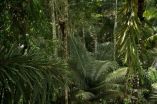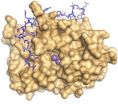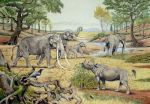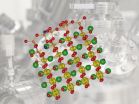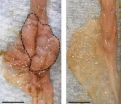(Press-News.org) Washington, D.C.— In many ways, plants act as chemical factories, using energy from sunlight to produce carbon-based energy and taking nutrients from the soil in order to synthesize a wide variety of products. Carnegie scientists asked the question: How much does the portfolio of chemicals generated by plants vary, depending on the surrounding environment, and what can this tell us about how we interact with forests? The answer involved climbing into the Amazonian canopy, resulting in the discovery that the forest's chemical portfolios form a rich mosaic that varies with elevation and soil content.
Their work is published by Proceedings of the National Academy of Sciences the week of March 3. The team focused their work in the western Amazon, a swath of forest stretching from the Andean tree line down to the Amazonian lowlands. A region of ultra-high biodiversity, the western Amazon harbors thousands of plant species that grow at different elevations and in different soils on different geologies. Amazonian canopy trees are of particular interest because they create the habitat occupied by a tremendous diversity of other plants and animals. They are also at great risk due to climate change and other human interference such as mining, cattle ranching, and agriculture.
The team climbed to the treetops to collect and analyze foliage from 3,560 canopies across 19 forests throughout Peru. They found that canopy chemical traits are organized in a large mosaic controlled by changes in the underlying soils and by elevation. Chemical variation across co-existing species greatly exceeded the variation within each species. These and other findings reveal that different Amazonian species make up a diverse matrix of growth and survival strategies that express how these forests assembled over evolutionary time.
"We discovered that this incredible region is a patchwork mosaic of trees with chemical signatures organized into communities to maximize their growth potential given their local soils and elevation -- two geological factors they must negotiate as living organisms. Within these communities, the trees have evolved chemical portfolios that are different from one another, maybe to help each species take a place in its community -- what we call a niche," explained lead author Greg Asner.
Forest canopies are notoriously difficult to study, given the extreme difficulty of accessing them. Thousands of samples had to be collected from the upper limits of the canopy to ensure they all had equal exposure to sunlight and could thus be compared in terms of solar-driven chemical synthesis. This meant using climbing techniques to reach the outer edge of each canopy, hundreds of feet above the surface. The leaves collected by the team include the vast majority of canopy tree species found in the western Amazon.
This study is the scientific debut for Carnegie's Spectranomics project, a field and laboratory-based effort to determine the relationship between function and biological diversity of plant species in tropical forests. Carnegie houses the world's first, and largest, library of dried and cryogenically frozen samples of tropical canopy trees, along with herbarium specimen vouchers. Current holdings include millions of samples from more than 10,000 tropical trees and other lifeforms painstakingly collected from around the globe.
"It is a fascinating experience to roam the sample archive in the Spectranomics Library, whether online or with samples in hand, and to contemplate how chemically diverse tropical canopies have become." noted Dr. Robin Martin, the project's long-time coordinator. Not only do the study's findings help us better understand the tremendous diversity of the region, they also provide a new basis for understanding how climate change and human activities on the ground might affect forest function in this century.
"I view the results as a wake-up call that we are shaking up a special tropical region full of chemically unique forest communities that have undergone millions of years of evolution and biogeographic construction," Asner said "Land use and climate change are two very obvious pressures on the western Amazon. They are already threatening whole patches in a kaleidoscopic quilt of chemical diversity that underpins these ecosystems."
INFORMATION:
The Spectranomics Project is made possible by the support of the John D. and Catherine T. MacArthur Foundation.
The Carnegie Institution for Science is a private, nonprofit organization headquartered in Washington, D.C., with six research departments throughout the U.S. Since its founding in 1902, the Carnegie Institution has been a pioneering force in basic scientific research. Carnegie scientists are leaders in plant biology, developmental biology, astronomy, materials science, global ecology, and Earth and planetary science.
Amazon's canopy chemistry is a patchwork quilt
2014-03-03
ELSE PRESS RELEASES FROM THIS DATE:
We want to save water, but do we know how?
2014-03-03
BLOOMINGTON, Ind. -- Many Americans are confused about the best ways to conserve water and have a slippery grasp on how much water different activities use, according to a national online survey conducted by an Indiana University researcher.
Experts say the best strategy for conserving water is to focus on efficiency improvements such as replacing toilets and retrofitting washing machines. However, the largest group of the participants, nearly 43 percent, cited taking shorter showers, which does save water but may not be the most effective action. Very few participants ...
Experimental stroke drug also shows promise for people with Lou Gehrig's disease
2014-03-03
Keck School of Medicine of USC neuroscientists have unlocked a piece of the puzzle in the fight against Lou Gehrig's disease, a debilitating neurological disorder that robs people of their motor skills. Their findings appear in the March 3, 2014, online edition of the Proceedings of the National Academy of Sciences of the United States of America, the official scientific journal of the U.S. National Academy of Sciences.
"We know that both people and transgenic rodents afflicted with this disease develop spontaneous breakdown of the blood-spinal cord barrier, but how these ...
Big stride in understanding PP1, the ubiquitous enzyme
2014-03-03
PROVIDENCE, R.I. [Brown University] — In the Proceedings of the National Academy of Sciences, a team of scientists at Brown University reports a major step forward in determining the specific behavior of the ubiquitous enzyme PP1 implicated in a wide range of diseases including cancer.
PP1, whose role is to enable the passage of molecular messages among cells, is found pretty much everywhere in the body. Its wide range of responsibilities means it is essential to many healthy functions and, when things go wrong, to diseases. But its very versatility has prevented it from ...
Mount Sinai study points to new biological mechanisms, treatment paradigm for kidney disease
2014-03-03
New York, NY – Prevention and reversal of chronic kidney disease is an urgent public health need. The disease affects 1 in 10 Americans, is debilitating and deadly, and existing drugs, at best, offer only mild delay in progression to end-stage kidney failure. New research led by Icahn School of Medicine at Mount Sinai investigators has uncovered abnormal molecular signaling pathways from disease initiation to irreversible kidney damage, kidney failure, and death. Results from their preclinical and human research are published online March 3 in the Journal of Clinical Investigation.
"Our ...
Researchers identify 'carbohydrates in a coal mine' for cancer detection
2014-03-03
Researchers at New York University and the University of Texas at Austin have discovered that carbohydrates serve as identifiers for cancer cells. Their findings, which appear in the journal Proceedings of the National Academy of Sciences, show how these molecules may serve as signals for cancer and explain what's going on inside these cells, pointing to new ways in which sugars function as a looking glass into the workings of their underlying structures.
"Carbohydrates can tell us a lot about what's going on inside of a cell, so they are potentially good markers for ...
New discovery solves problem of anti-inflammatory substance
2014-03-03
There have been great expectations regarding the production of a drug to block the enzyme LTA4 hydrolase, which plays a key role in the body's inflammatory response. However, in clinical trials, such molecules have proven to be only moderately effective. Now, researchers at Karolinska Institutet have successfully refined their understanding of why previous substances have been less effective – and in so doing have produced a molecule that gets around the problem. Consequently, there is once again hope of a new anti-inflammatory drug based on the principal of blocking LTA4 ...
Large mammals were the architects in prehistoric ecosystems
2014-03-03
Researchers from Denmark demonstrate in a study that the large grazers and browsers of the past created a mosaic of varied landscapes consisting of closed and semi-closed forests and parkland. The study will be published on Monday 3 March 2014 in the renowned journal PNAS (Proceedings of the National Academy of Sciences of the United States of America).
Dung beetles recount the nature of the past
The biologists behind the new research findings synthesized decades of studies on fossil beetles, focusing on beetles associated with the dung of large animals in the past ...
Electronics based on a 2-D electron gas
2014-03-03
Usually, microelectronic devices are made of silicon or similar semiconductors. Recently, the electronic properties of metal oxides have become quite interesting. These materials are more complex, yet offer a broader range of possibilities to tune their properties. An important breakthrough has now been achieved at the Vienna University of Technology: a two dimensional electron gas was created in strontium titanate. In a thin layer just below the surface electrons can move freely and occupy different quantum states.
Strontium titanate is not only a potential future alternative ...
Gut microbes spur development of bowel cancer
2014-03-03
It is not only genetics that predispose to bowel cancer; microbes living in the gut help drive the development of intestinal tumors, according to new research in mice published in the March issue of The Journal of Experimental Medicine.
Bowel cancer, also called colorectal cancer, results from a series of genetic changes (mutations) that cause healthy cells to become progressively cancerous, first forming early tumors called polyps that can eventually become malignant. Although mutations can occur anywhere in the human intestine, certain types of colorectal cancer tend ...
In academia, men more likely to cooperate with lower-ranked colleagues
2014-03-03
In academic circles at least, women tend to cooperate with same-sex individuals of higher or lower rank less often than men do. So say researchers who report evidence on March 3 in the Cell Press journal Current Biology. The findings are based on a study of the publication records of professors working at 50 North American universities.
"People are often upset to hear evidence of sex differences in behavior," says Joyce Benenson of Harvard University. "But the more we know, the more easily we can promote a fair society."
The findings might seem somewhat counterintuitive. ...

